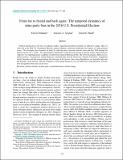From foe to friend and back again: The temporal dynamics of intra-party bias in the 2016 U.S. presidential election
Author(s)
Dunham, Y; Arechar, AA; Rand, DG
DownloadPublished version (714.2Kb)
Publisher with Creative Commons License
Publisher with Creative Commons License
Creative Commons Attribution
Terms of use
Metadata
Show full item recordAbstract
© 2019. The authors license this article under the terms of the Creative Commons Attribution 3.0 License. Political identification is the basis of enduring conflict, suggesting that political attitudes are difficult to change. Here we show that in the 2016 U.S. Presidential Election, political identities underwent modification in response to salient political events. We investigate these dynamics in detail by collecting data at periodic intervals from mid-June 2016 through the general election (N = 3,958). We operationalize identification using prosocial giving in Dictator Games played between supporters of competing primary candidates recruited from Amazon Mechanical Turk. The observed dynamics differed across political parties. In-group bias among Democrats remained high until the Democratic National Convention, disappeared shortly thereafter, and then returned during the final stage of the election. Bias among Republicans was generally high until the final days of the election. The late resurgence of bias among Democrats was not reflected in voting intentions, but may have presaged the Democratic election loss.
Date issued
2019-05-01Department
Sloan School of Management; Massachusetts Institute of Technology. Department of Brain and Cognitive SciencesJournal
Judgment and Decision Making